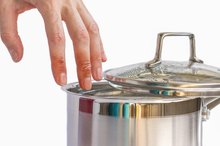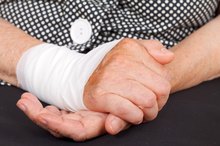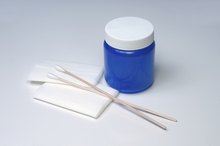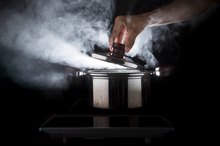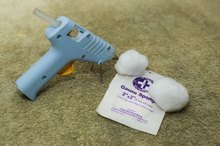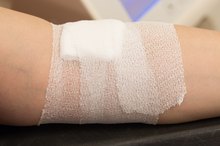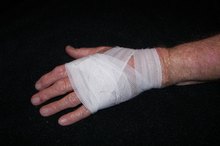How to Treat Burns Caused by Boiling Water
Approximately 486,000 people in the US visit hospital emergency rooms each year for burn injuries, according to the American Burn Association 1. Scalds — burns caused by steam or hot liquids — are the second most common type of burn injury in adults and the leading type among young children.
Most scalds due to boiling water are first- or second-degree burns. Small scald injuries can often be treated at home, although larger burns and those involving certain parts of the body require immediate medical evaluation.
Cool the Skin
Immediately remove any clothing that got splashed with the boiling water. Also remove any jewelry in the area of the burn, if possible. Place the scalded area under gently running cold water from a faucet for 20 minutes to dissipate the heat in the skin and arrest the burning process.
If this isn't feasible, such as with a crying child, fill a pitcher with cold water. Place the scalded area over a catch basin or large pot and gently pour the water over the burned skin. Refill the pitcher as needed. Continue pouring cold water over the burned skin for 20 minutes.
Do not place ice or ice water on the burned area as this could further damage the skin. Gently pat the skin dry after cooling.
- Immediately remove any clothing that got splashed with the boiling water.
- Place the scalded area over a catch basin or large pot and gently pour the water over the burned skin.
Evaluate the Burn
How to Treat a Blistering Burn on Finger
Learn More
After cooling the skin, evaluate the burn. Seek medical care right away at the nearest emergency room or urgent care center if any of the following apply:
- The burn is larger than the size of the burned person's hand.
- The scalded area blisters and involves the face, hands, arms, feet, legs or genitals.
- The pain remains severe.
- The burned person is feeling unwell or has diabetes.
- You are unsure about whether medical evaluation is needed, especially if a child has been burned.
Cover the burn with piece of plastic wrap and gently secure in place with first aid tape or adhesive bandages. Do not wrap the plastic all the way around the involved area as this could reduce circulation if swelling occurs. If the boiling water scalded the hand, you can place it in a new plastic storage bag rather than plastic wrap.
- After cooling the skin, evaluate the burn.
- Seek medical care right away at the nearest emergency room or urgent care center if any of the following apply: * The burn is larger than the size of the burned person's hand.
* The scalded area blisters and involves the face, hands, arms, feet, legs or genitals.
Continue Home Care
If the burn does not require medical evaluation, you can continue with home treatment. Loosely cover the burn with a nonstick bandage to protect the damaged skin and reduce the chance of infection.
Do not apply any type of grease or butter, or any creams or ointments to the burn. Change the bandage at least daily or more frequently if it gets wet. Do not rupture or drain any blisters that might form. Keep the burn covered until it has healed.
An over-the-counter pain reliever such as acetaminophen (Tylenol) or ibuprofen (Advil, Motrin) can be used for burn-related pain if the medicine has been previously okayed by your doctor.
Follow the home care instructions provided to you by the hospital or urgent care center if you sought medical evaluation and treatment for the burn.
- If the burn does not require medical evaluation, you can continue with home treatment.
Warnings and Precautions
How to Prevent Scarring From a Steam Burn
Learn More
It sometimes takes several hours for the full extent of a burn to become apparent. Therefore, seek medical evaluation if any of the criteria noted previously that signal the need for immediate medical evaluation develop in the hours following the scald. Also seek urgent medical care if the pain worsens; the redness surrounding burn expands ; red streaks that radiate from burn develop; or fever or chills occur.
Related Articles
References
- American Burn Association: Burn Incidence Fact Sheet
- Stat Pearls: Burns, Thermal
- BMJ: Emergency and Early Management of Burns and Scalds
- Advanced First Aid, CPR, and AED, 7th Edition; Alton L. Thygerson, et al.
- Cuttle L, Pearn J, McMillan JR, Kimble RM. A review of first aid treatments for burn injuries. Burns. 2009;35(6):768-775. doi:10.1016/j.burns.2008.10.011
- Lloyd ECO, Rodgers BC, Michener M, Williams MS. Outpatient burns: prevention and care. Am Fam Physician. 2012;85(1):25-32.
- Shrivastava P, Goel A. Pre-hospital care in burn injury. Indian J Plast Surg. 2010;43(Suppl):S15-S22. doi:10.4103/0970-0358.70720
- Nielson CB, Duethman NC, Howard JM, Moncure M, Wood JG. Burns: Pathophysiology of Systemic Complications and Current Management. J Burn Care Res. 2017;38(1):e469-e481. doi:10.1097/BCR.0000000000000355
- Schaefer TJ, Tannan SC. Thermal Burns. In: StatPearls. Treasure Island, FL: StatPearls Publishing; 2019.
- Cancio LC, Barillo DJ, Kearns RD, et al. Guidelines for Burn Care Under Austere Conditions: Surgical and Nonsurgical Wound Management. J Burn Care Res. 2017;38(4):203-214. doi:10.1097/BCR.0000000000000368
- Lloyd ECO, Rodgers BC, Michener M, Williams MS. Outpatient burns: prevention and care. Am Fam Physician. 2012;85(1):25-32.
- Munteanu A, Florescu IP, Nitescu C. A modern method of treatment: The role of silver dressings in promoting healing and preventing pathological scarring in patients with burn wounds. J Med Life. 2016;9(3):306-315.
Resources
Writer Bio
Dr. Tina M. St. John owns and operates a health communications and consulting firm. She is also an accomplished medical writer and editor, and was formerly a senior medical officer with the U.S. Centers for Disease Control and Prevention. St. John holds an M.D. from Emory University School of Medicine.
